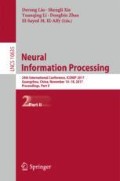Abstract
Recently, the bimodal BCI has attracted more and more attention. Previous studies have reported that the classification performance of bimodal system was better than that of unimodal system. Based on the fundamental visual-tactile P300 BCI, this paper made a change on the flash pattern of visual stimuli expecting to improve its performance by enhancing the link between visual and tactile modalities. Two patterns were tested in this paper, which respectively were picture-vibrate pattern (producing the visual effect of vibration) and color-change pattern (changing blue to green). The results showed that the picture-vibrate pattern achieved higher classification accuracy and information transfer rate than color-change pattern. The average online bit rate of picture-vibrate pattern including the breaking time between selections, reached 12.49 bits/min, while the color-change pattern’s online bit rate reached 8.87 bits/min on average.
Access this chapter
Tax calculation will be finalised at checkout
Purchases are for personal use only
References
Mak, J.N., Wolpaw, J.R.: Clinical applications of brain-computer interfaces: current state and future prospects. IEEE Rev. Biomed. Eng. 2, 187–199 (2009)
Wolpaw, J.R., Birbaumer, N., Mcfarland, D.J., Pfurtscheller, G., Vaughan, T.M.: Brain-computer interfaces for communication and control. Clin. Neurophysiol. 113(6), 767–791 (2002)
Farwell, L.A., Donchin, E.: Talking off the top of your head: toward a mental prosthesis utilizing event-related brain potentials. Electroencephalogr. Clin. Neurophysiol. 70(6), 510–523 (1988)
Sellers, E.W., Mcfarland, D.J.: Toward enhanced P300 speller performance. J. Neurosci. Meth. 167(1), 15–21 (2008)
Jin, J., Sellers, E.W., Zhou, S., Zhang, Y., Wang, X., Cichocki, A.: A p300 brain-computer interface based on a modification of the mismatch negativity paradigm. Int. J. Neural Syst. 25(3), 595–599 (2015)
Jin, J., Allison, B.Z., Zhang, Y., Wang, X., Cichocki, A.: An ERP-based BCI using an oddball paradigm with different faces and reduced errors in critical functions. Int. J. Neural Syst. 24(8), 1450027 (2014)
Hill, N.J., Lal, T.N., Bierig, K., Birbaumer, N., Schölkopf, B.: An auditory paradigm for brain–computer interfaces. In: Saul, L.K., Weiss, Y., Botton, L. (eds.) Advances in Neural Information Processing Systems, vol. 17, pp. 569–576. MIT Press, Cambridge (2005)
Brouwer, A.M., van Erp, J.B.F.: A tactile P300 brain-computer interface. Front. Neurosci. 4, 19 (2010)
Aloise, F., Lasorsa, I., Schettini, F., Brouwer, A., Mattia, D., Babiloni, F., Salinari, S., Marciani, M.G., Cincotti, F.: Multimodal stimulation for a P300-based BCI. Int. J. Bioelectromagn. 9(3), 128–130 (2007)
Kaufmann, T., Holz, E.M., Kübler, A.: Comparison of tactile, auditory, and visual modality for brain-computer interface use: a case study with a patient in the locked-in state. Front. Neurosci. 7, 129 (2012)
Ortner, R., Lugo, Z., Prückl, R., Hintermüller, C., Noirhomme, Q., Guger, C.: Performance of a tactile P300 speller for healthy people and severely disabled patients. In: Conference Proceedings of IEEE Engineering in Medicine and Biology Society, pp. 2259–2262. IEEE Press, Osaka (2013)
van der Waal, M., Severens, M., Geuze, J., Desain, P.: Introducing the tactile speller: an ERP-based brain-computer interface for communication. J. Neural Eng. 9(4), 045002 (2012)
Mori, H., Makino, S., Rutkowski, Tomasz M.: Multi–command chest tactile brain computer interface for small vehicle robot navigation. In: Imamura, K., Usui, S., Shirao, T., Kasamatsu, T., Schwabe, L., Zhong, N. (eds.) BHI 2013. LNCS, vol. 8211, pp. 469–478. Springer, Cham (2013). doi:10.1007/978-3-319-02753-1_47
Rutkowski, T.M., Mori, H.: Tactile and bone-conduction auditory brain computer interface for vision and hearing impaired users. J. Neurosci. Methods 244, 45–51 (2015)
Kaufmann, T., Herweg, A., Kübler, A.: Toward brain-computer interface based wheelchair control utilizing tactually-evoked event-related potentials. J. Neuroeng. Rehabil. 11(1), 7 (2014)
Herweg, A., Gutzeit, J., Kleih, S., Kübler, A.: Wheelchair control by elderly participants in a virtual environment with a brain-computer interface (BCI) and tactile stimulation. Biol. Psychol. 121, 117–124 (2016)
Brouwer, A.M., Erp, J.B.F.V., Aloise, F., Cincotti, F.: Tactile, visual, and bimodal P300s: could bimodal P300s boost BCI performance. SRX Neurosci. 2010, 1–9 (2010)
Thurlings, M.E., Brouwer, A.M., Erp, J.B.F.V., Werkhoven, P.: Gaze-independent ERP-BCIs: augmenting performance through location-congruent bimodal stimuli. Front. Neurosci. 8, 143 (2014)
Yin, E., Zeyl, T., Saab, R., Hu, D., Zhou, Z., Chau, T.: An auditory-tactile visual saccade-independent P300 brain–computer interface. Int. J. Neural Syst. 26(1), 1650001 (2016)
Driver, J., Noesselt, T.: Multisensory interplay reveals crossmodal influences on ‘Sensory-specific’ brain regions, neural responses, and judgments. Neuron 57(1), 11–23 (2008)
Hoffmann, U., Vesin, J.M., Ebrahimi, T., Diserens, K.: An efficient P300-based brain-computer interface for disabled subjects. J. Neurosci. Meth. 167(1), 115–125 (2008)
Acknowledgement
This work was supported by the Grant National Natural Science Foundation of China, under Grant Nos. 91420302, 61573142. This work was also supported by the Fundamental Research Funds for the Central Universities (WH1516018, 222201717006) and Shanghai Chenguang Program under Grant 14CG31.
Author information
Authors and Affiliations
Corresponding author
Editor information
Editors and Affiliations
Rights and permissions
Copyright information
© 2017 Springer International Publishing AG
About this paper
Cite this paper
Sun, H., Jin, J., Zhang, Y., Wang, B., Wang, X. (2017). An Improved Visual-Tactile P300 Brain Computer Interface. In: Liu, D., Xie, S., Li, Y., Zhao, D., El-Alfy, ES. (eds) Neural Information Processing. ICONIP 2017. Lecture Notes in Computer Science(), vol 10635. Springer, Cham. https://doi.org/10.1007/978-3-319-70096-0_79
Download citation
DOI: https://doi.org/10.1007/978-3-319-70096-0_79
Published:
Publisher Name: Springer, Cham
Print ISBN: 978-3-319-70095-3
Online ISBN: 978-3-319-70096-0
eBook Packages: Computer ScienceComputer Science (R0)

